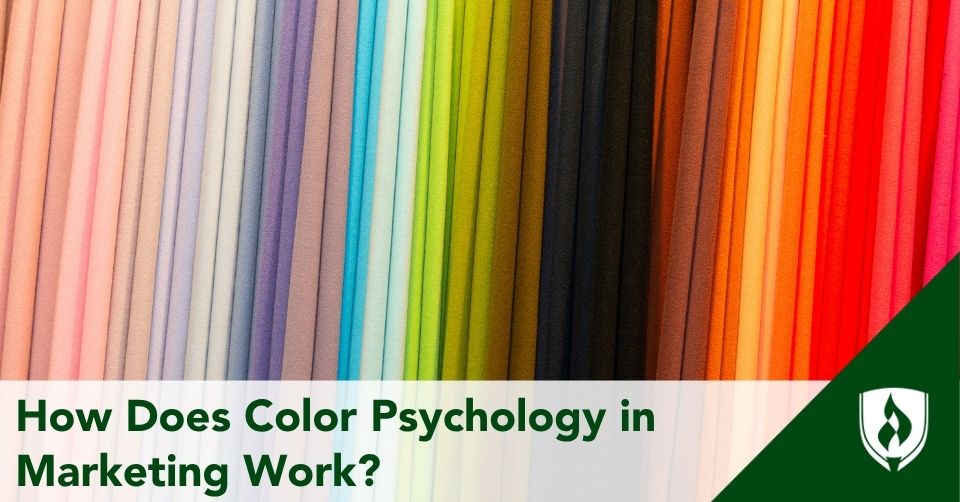
The bold color red of Coca-Cola®.
The vibrant pink of Victoria’s Secret®.
The bold fuchsia of T-Mobile®.
Many brands use color psychology in marketing to stand out, evoke feelings and influence human behavior. Color is more than just a visual experience—it's a powerful psychological principle that plays a major role in how consumers view brands, make purchases and stay loyal to those brands.
But does color psychology actually work in marketing?
Let’s dive into the data, the theory and best practices to see how color really affects consumer decisions, and how this topic could be beneficial when considering a career in marketing.
What is color psychology in marketing?
Color psychology in marketing is the study of how colors and color combinations influence buyer behavior, brand perception and emotional response. This approach taps into the psychology of color, using the color spectrum and color theory to create a color palette that supports a brand's identity and marketing strategy.
Marketers use the color wheel—a foundational tool in color theory—to select the right color combinations, including complementary colors and primary colors, to grab attention and convey feelings like trust, excitement or sophistication.
The science behind color psychology in marketing
Recent research shows that certain brand colors are strongly linked to emotional responses from customers, which can shape how people remember and connect with a brand.
This make sense when you consider that certain colors trigger specific feelings:
- Red: urgency, excitement, passion (used by Coca-Cola® and Target®)
- Blue: trust, stability, professionalism (used by Facebook®)
- Yellow: optimism, energy, warmth
- Green: nature, health, freshness (high quality products, organic brands)
- Purple: luxury, creativity, wisdom (used by Hallmark®)
- Orange: enthusiasm, affordability, youthfulness
- Pink: femininity, romance, softness
- Black and White: elegance, simplicity, minimalism (used by Nike®)
These emotional responses are important to how color affects our perception of a particular brand and whether we choose to engage with it or not.
How colors shape brand identity and recognition
The brand color you choose helps define your brand personality. A youthful, fun company might choose bold, high contrast colors like orange and purple, while a luxury brand will likely focus on deep blues, blacks or muted golds.
Using a well-thought-out color palette helps:
- Increase brand recognition
- Strengthen brand identity
- Shape how potential customers view your business
- Align with your marketing goals
Real life example: Coca-Cola® and color psychology
Coca-Cola’s iconic red isn’t just eye-catching—it stimulates appetite and excitement, which matches perfectly with a product meant to be refreshing and energizing.
Cultural differences and personal preferences
While color psychology provides general guidelines, it’s important to note that personal preferences, cultural differences and individual experiences can dramatically shift how a color affects someone.
For example:
- White symbolizes purity in Western cultures (like a wedding dress) but mourning in some Eastern cultures (white flowers at a funeral).
- Red may evoke feelings of love in some markets and aggression or negative emotions in others.
- The color blue, seen as calming and trustworthy in the U.S., may hold different associations elsewhere.
If you are planning to pursue a career in marketing, always consider the cultural context when designing marketing materials for global campaigns.
Best practices for using color psychology in marketing
- Know your target audience
Research what colors resonate with your specific demographic, taking into account age, gender and culture. - Define your brand personality
Is the brand fun and youthful or premium and elegant? The brand color should reflect that identity. - Use a color psychology chart
Use a color psychology chart to understand the color associations that will best persuade consumers. - Stick to a consistent color palette
Your website, ads, packaging, and social media should use a consistent color palette to reinforce your brand identity. - Use high contrast for readability
Especially in digital marketing materials, use high contrast between text and background to increase accessibility and clarity. - Test and optimize
Test certain shades or color combinations to see which versions resonate better with your audience.
Color psychology and brand loyalty
Beyond first impressions, color psychology in marketing can help build lasting emotional connections. As a marketer, using the same brand colors across all platforms strengthens consumer trust and brand loyalty.
Think about how instantly recognizable the color red is for Coca-Cola® or Target®. It isn't just a color—it's a part of the company’s DNA.
The limits of color psychology in marketing
While color psychology is a powerful tool, it’s not a magic bullet. If you're going to pursue a career in marketing, your campaigns still need:
- A solid product
- Clear messaging
- Strategic positioning
- An understanding of personal experiences and individual differences
Also, beware of relying too heavily on color without considering cultural context or the risk of negative reactions, like using neon green for a luxury brand.
Is color psychology in marketing effective?
Absolutely—when used correctly.
It's not just about choosing your favorite color. It's about understanding how color affects perception, emotion and behavior. It’s about aligning your marketing colors with your brand, your target audience, and your overall marketing strategy.
From attracting attention to building trust, color is an important factor in brand success.
Whether you're choosing between cool colors and warm colors, or building a brand from scratch, the right color choices can help you connect more deeply with potential customers and set your client's name apart in a crowded market.
Color psychology is one of the many fascinating things business students learn in a marketing program. If you like learning about this kind of thing—maybe marketing is a good career direction to consider! Check out Is a Marketing Degree Worth It? to see a bit more about what a marketing education is all about.
Coca-Cola® is a registered trademark of The Coca-Cola Company.
Victoria’s Secret® is a registered trademark of Victoria's Secret Stores Brand Management, LLC.
T-Mobile® is a registered trademark of Deutsche Telekom AG Friedrich-Ebert-Allee.
Nike® is a registered trademark of Nike, Inc.
Hallmark® is a registered trademark of Hallmark Licensing LLC.
Facebook® is a registered trademark of Meta Platforms, Inc.
Target® is a registered trademark of Target Brands, Inc.




